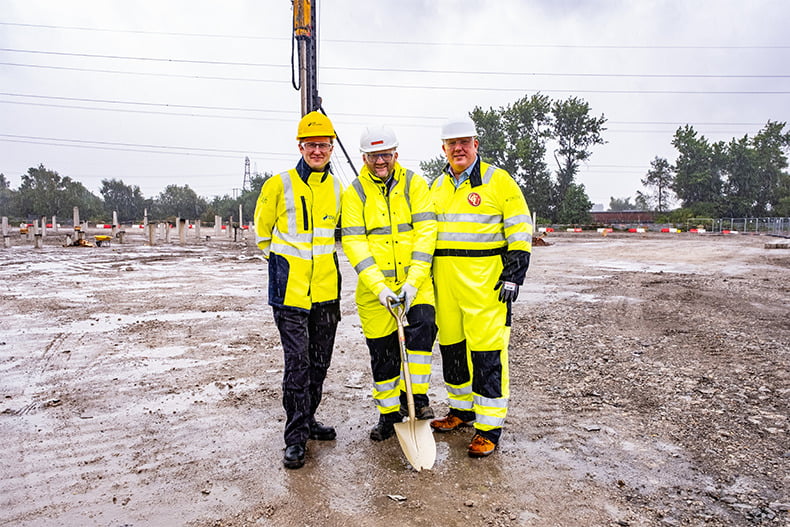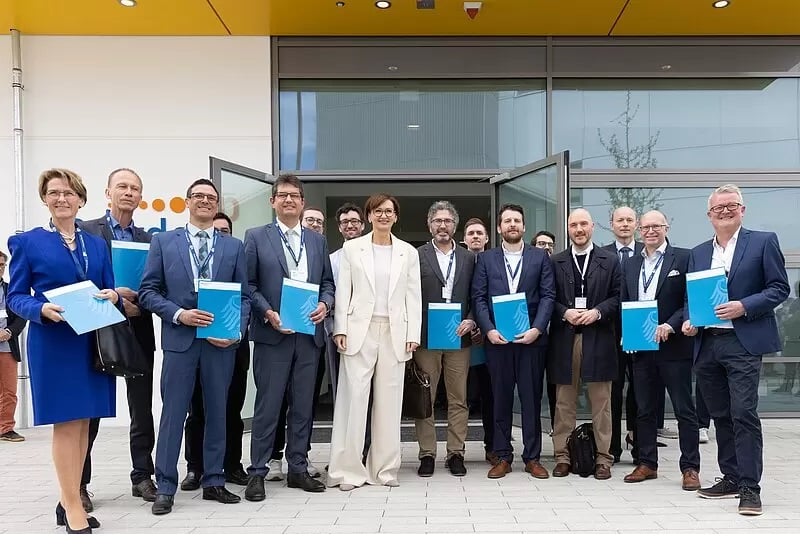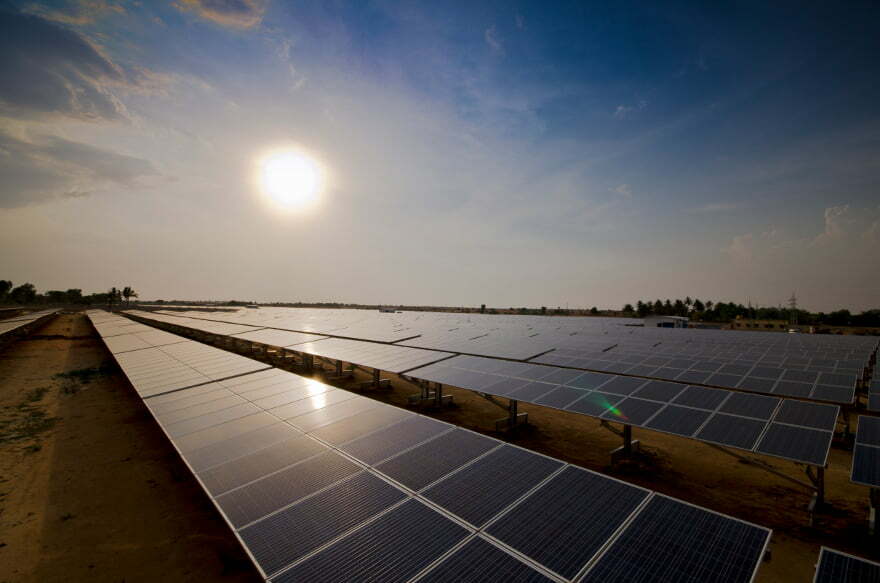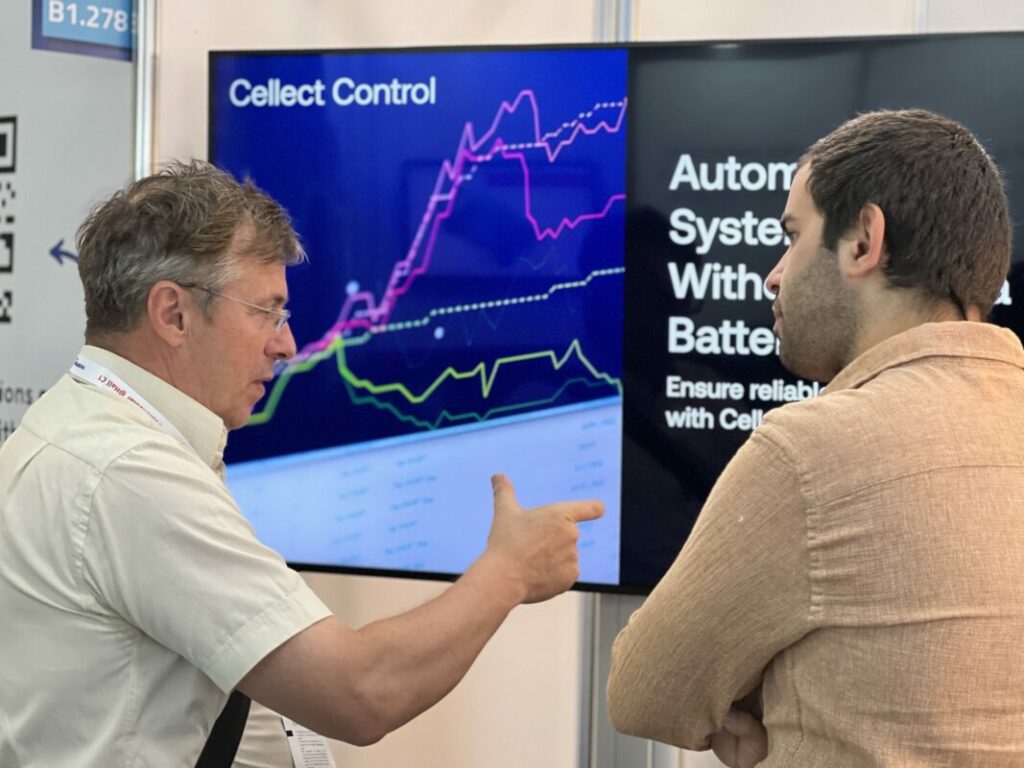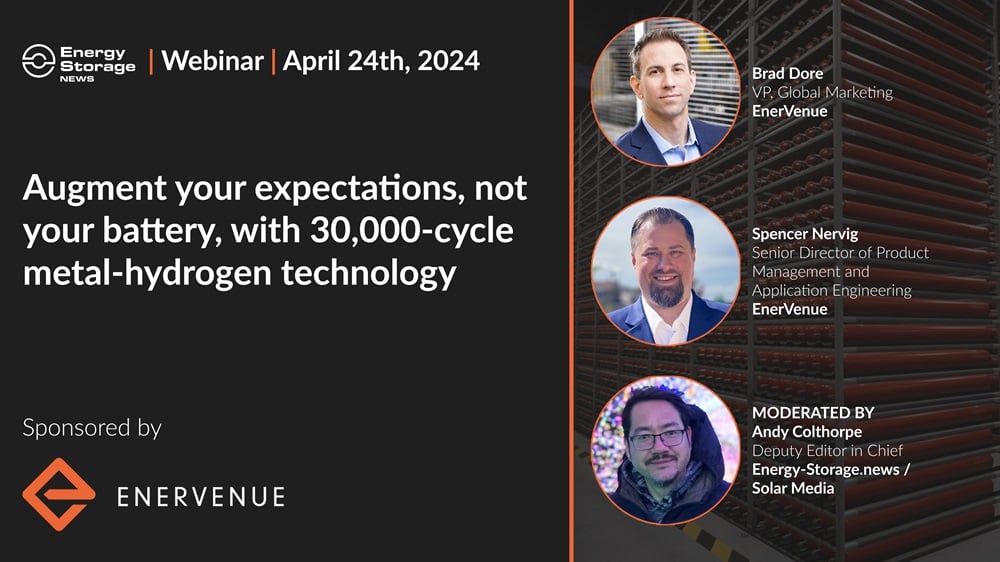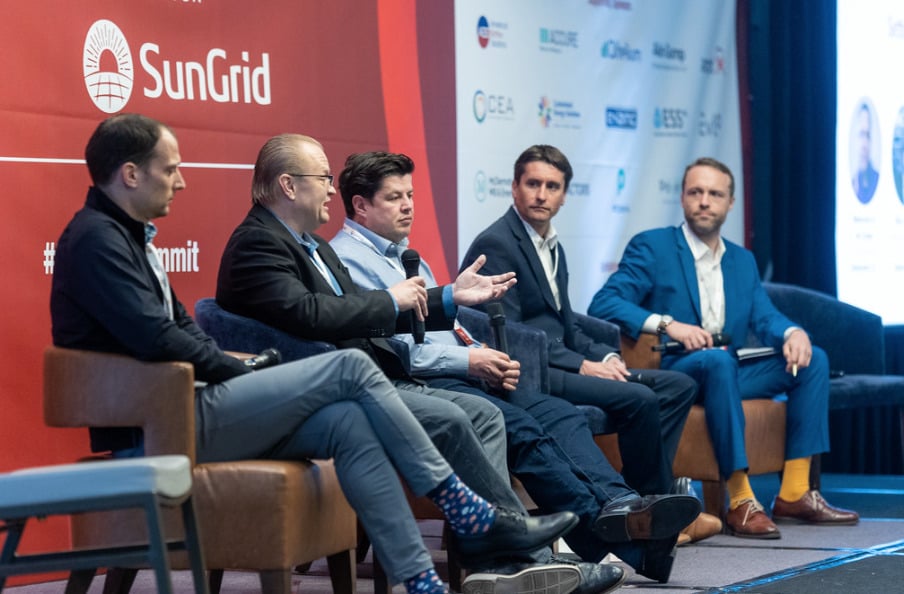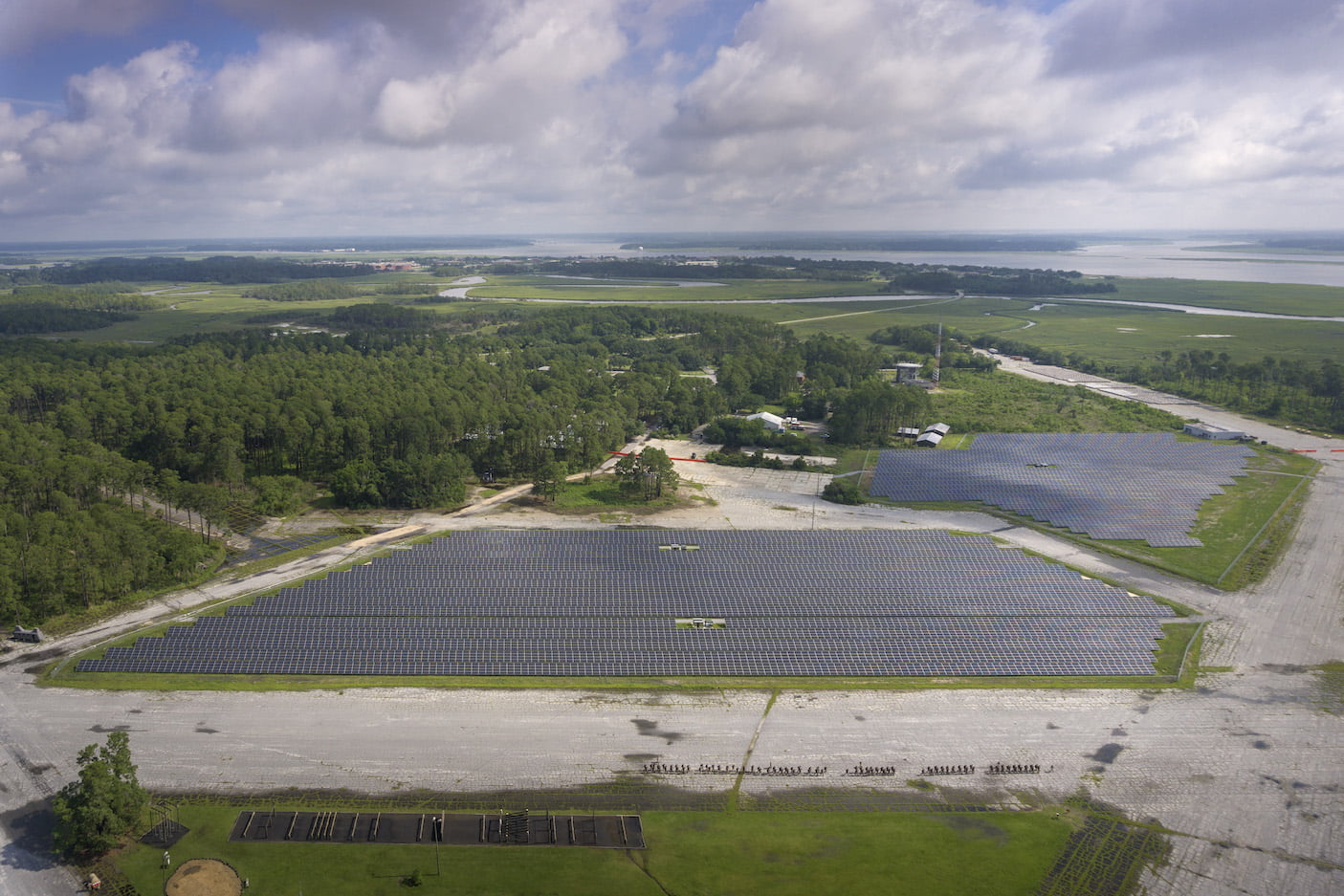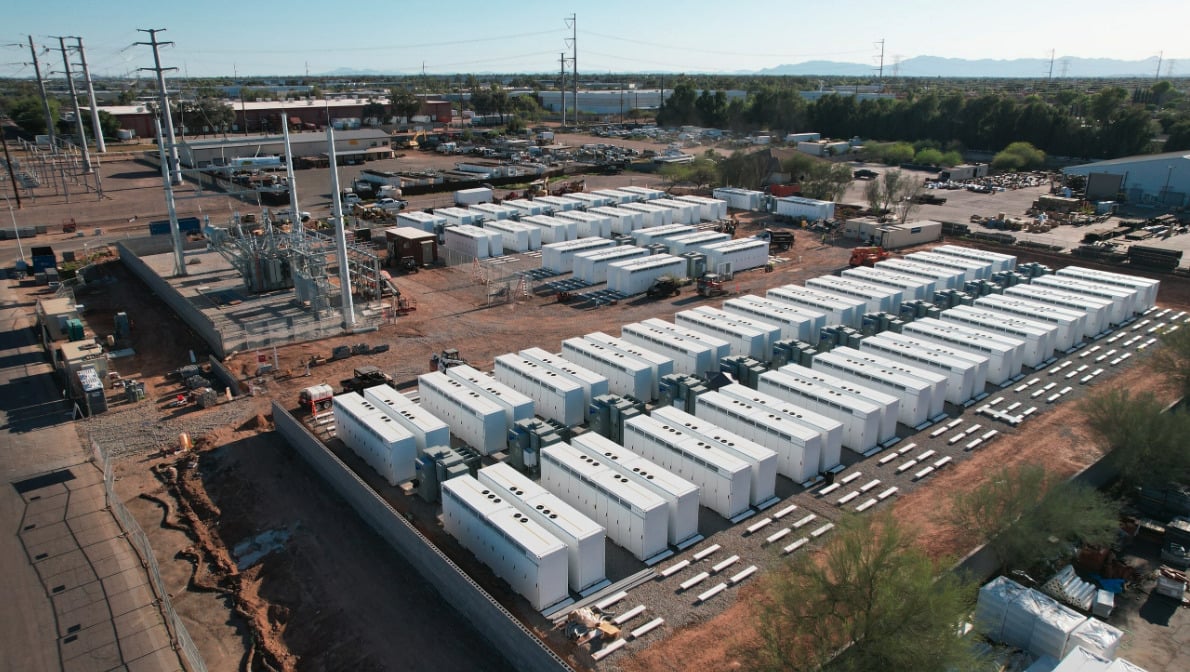Subject to a final investment decision by SSE Renewables, the shovel-ready project will be constructed on a greenfield site located outside Coalisland, around five miles from Dungannon.
If approved for final delivery, construction could commence early next year and the BESS would be operational by the end of 2026. It will connect to the grid via an underground cable to the nearby existing Tamnamore substation.
This is SSE Renewables’ first battery storage development in Northern Ireland, having already an established green portfolio in Britain. The firm launched its first operational BESS in the GB market on 15 April in the form of a 50MW/100MWh asset located in Salisbury, Wiltshire.
To see the full, original version of this article go to Solar Power Portal.
ROUNDUP: Ambri for sale, Varta leads sodium-ion initiative, ESS Inc completes airport project
Ambri has been commercialising a high-temperature battery technology based around liquid calcium anodes and molten salt electrolyte, with solid antimony particles in the cathode since 2010.
It claims the materials used in its battery are abundant and that the tech can cost-effectively serve long-duration energy storage (LDES) applications.
According to filings with the US Bankruptcy Court for the District of Delaware, its decision to make the Chapter 11 declaration was taken at a special meeting of the company’s board on 3 May 2024.
Ambri’s lenders include Gates Frontier, the venture capital (VC) arm of Microsoft co-founder Bill Gates’ eponymous foundation, private investment firm Paulson Partners, and India’s Reliance Industries, which invested in the company in 2022.
Reliance is also among a number of partners that have agreed to pilot the Ambri liquid metal technology, along with US utility company Xcel Energy in Colorado, and Microsoft for a US data centre project.
Ambri said it has received financing commitments from its lender consortium and expects the sale process to be approved in July this year.
Varta leads German government-funded Na-ion consortium
The German Federal Ministry of Research and Education (BMBF) has approved funding for a consortium on sodium-ion (Na-ion) batteries for energy storage applications.
The consortium of 15 companies and universities will research and develop sodium-ion batteries, aiming to develop high-performance, environmentally friendly cells which can be produced on an industrial scale.
It is being led by German battery manufacturer Varta, which initiated the effort. The company has also been appointed as its coordinator, with the project scheduled to start at the beginning of June.
Bettina Stark-Watzinger, federal minister for research, handed over official documents to mark the ministry’s approval of around €7.5 million (US$8.07 million) in funding last Thursday (2 May).
“In order to further advance the future of decentralised energy storage and use, other innovative and powerful storage technologies are needed in addition to lithium-ion technology,” Varta CTO Rainer Hald said.
“In addition to existing technologies, sodium-ion batteries can make an important, sustainable contribution to the decarbonisation and electrification of many areas in order to actively shape the energy and mobility transition.”
The event followed the minister’s attendance a couple of days previously at an event to break ground on the Fraunhofer Research Institution’s FFB Battery Cell Production centre in Münster, western Germany.
FFB will “test innovative battery technologies as well as develop novel battery cell concepts and efficiently bring them to market maturity,” Stark-Watzinger said. Ministry BMBF will put €500 million into the development of the FFB facility.
ESS Inc commissions flow battery project at Amsterdam’s Schiphol airport
Iron electrolyte flow battery maker ESS Inc has commissioned the first planned phase of an energy storage project at Amsterdam Airport Schiphol, the Netherlands.
The flow battery system will help reduce reliance on diesel fuel for powering ground operations at the international airport. Ground power units that burn diesel to provide electrical power to parked stationary aircraft will instead be replaced with so-called Electric Ground Power Units (E-GPUs).
US-headquartered ESS Inc holds the IP for the flow battery technology behind these E-GPUs. Although the sizing, capacity, and storage duration of the Schiphol project have not been disclosed, the tech company said in January 2023, as the project was announced, that it would utilise ESS Inc Energy Warehouse units, each of which is 75kW output with 400kWh max capacity.
The airport installation is part of a wider European Union (EU) project called TULIPS to develop innovative low-carbon mobility and aviation solutions. The EU is backing TULIPS with €25 million funding. When the project was awarded early last year, ESS Inc. said its long-duration energy storage (LDES) solution’s safety and sustainability profiles were key to its selection.
India: Tata Power signs PPA for firm, dispatchable energy from wind, solar and storage
The project will deliver renewable energy to the grid during peak demand hours. TPREL must deliver it to commercial operations within 24 months of the PPA’s signing. Financial terms of the deal have not been disclosed.
TPREL was awarded the contract in a tender hosted by SJVN, a power generation and transmission company owned and operated as a joint venture (JV) between the government of India and the state government of Himachal Pradesh.
SJVN has been selected as one of the public entities to host the FDRE tenders, recently described as the “ideal” structure for encouraging investment in energy storage for India, by the Institute for Energy Economics and Financial Analysis (IEEFA) and JMK Research.
In a report published last December, the research and analysis groups said that energy storage—including pumped hydro energy storage (PHES) as well as batteries—would be the “major disrupter” of India’s power market in this decade.
More than 8GW of tenders to procure energy storage resources were launched during 2023 in India by state and national government agencies, most prominently by the Solar Energy Corporation of India (SECI).
Tender structures have included solicitations for solar-plus-storage projects, peak power supply, ‘round-the-clock’ (24/7) renewable energy delivery and standalone energy storage as well as FDRE tenders, which made their market debut last year.
However, while each structure may be beneficial under different circumstances, it was the FDRE tenders that Jyoti Gulia, JMK Research founder, said could “create a win-win scenario” for developers and offtakers.
This is because, Gulia said, FDRE tenders are tailored to the demand profile of the procuring agency or offtaker. For example, SJVN launched another such tender at the end of March, seeking 600MW of FDRE resources.
While Tata Power’s subsidiary has won tenders under various structures, its deal with SJVN marks the first it has sealed under an FDRE requirement.
“By integrating diverse renewable energy sources and leveraging the importance of firm and dispatchable renewable energy (FDRE), the collaboration will ensure a dependable power supply and also actively contribute to India’s ambitious renewable energy targets,” TPREL managing director and CEO Deepsh Nanda said.
India is targeting the deployment of 500GW of non-fossil fuel energy sources by 2030, and is thought to be just under halfway to that target. Around 15GW of solar PV was deployed in 2023, according to figures from the Ministry of New and Renewable Energy (MNRE).
Integrating new solar and wind as part of that target, as well as achieving other national energy goals such as stabilising the grid and increasing access to electricity for rural populations will require 74GW/411GWh by 2032 from PHES and battery energy storage system (BESS) resources, the country’s Central Electricity Authority (CEA) has projected.
Breaking communication barriers between asset management and O&M is essential for ESS operations
However, a hidden challenge lurks behind the scenes: fragmented communication between asset managers and operations & maintenance (O&M) teams. This often leads to the formation of data silos, hindering optimal performance and creating unnecessary friction within energy storage operations.
Data silos: A barrier to asset efficiency
Data silos occur when critical information is isolated within specific departments. In the context of energy storage, this manifests in two distinct data sets:
Asset management data: This data focuses on the financial and operational aspects of the storage system. It includes information like operational schedules, financial models, historical performance metrics, and energy market trends. Asset managers leverage this data to make informed decisions regarding revenue generation, scheduling energy sales, and optimising battery configurations.
Operations & maintenance data: This data delves into the technical health and performance of the battery system. It comprises operational data, maintenance logs, and equipment performance reports. Engineers rely on this data to ensure the system’s smooth operation, identify potential problems, and schedule preventative maintenance.
Without a seamless exchange of this information, both asset managers and O&M teams operate with an incomplete picture.
Imagine this scenario: The asset manager identifies a lucrative opportunity to sell energy back to the grid during a peak demand period. However, they might be unaware of a planned maintenance window for the same period due to a lack of communication. This missed opportunity highlights the cost of siloed data and its detrimental impact on maximising revenue potential.
High cost of miscommunication between asset management and O&M teams
The consequences of siloed data go well beyond just missing out on opportunities. Inefficient downtime management, for instance, results from delayed incident responses due to unclear communication channels, leading to prolonged downtime and significant revenue loss.
This situation is heightened when maintenance opportunities are missed because asset managers are not informed of potential issues the operations & maintenance team flagged during routine checks. Similarly, energy production shortfalls occur when assets are underutilised because O&M teams might need to take systems offline for maintenance when assets are to be marketed, leading to financial penalties and reduced energy output.
Moreover, the lack of transparency around operational schedules and conflicting priorities can result in friction and frustration among teams. O&M engineers face difficulties in knowing when the system should be operational.
At the same time, asset managers are restricted by maintenance activities that interfere with their plans for generating revenue, creating a cycle of tension that stifles progress and diminishes overall efficiency.
From silos to symphonies
Energy storage professionals can benefit from fostering collaboration and secure data exchange. Real-time optimisation allows asset managers to utilise operations and maintenance insights on asset performance and health to adjust configurations to increase revenue.
Informed decisions will always be the key to success for ESS assets. Image: Cellect.
This includes modifying charging/discharging cycles, optimising for ancillary service markets like Frequency Containment Reserve (FCR) and Automatic Frequency Restoration Reserve (aFRR), or responding to energy price fluctuations.
Planned maintenance enables O&M teams to schedule maintenance during low-demand periods, reducing downtime and ensuring peak system efficiency. Shared dashboards, communication platforms, and coordinated workflows accomplish unified goals in energy storage projects by aligning departments toward common objectives and fostering shared responsibility.
This setup empowers stakeholders to make informed decisions, thereby enhancing project success.
“Client feedback demands a centralised platform for seamless communication and data exchange, which optimises projects and fosters a collaborative energy ecosystem,” says Leon Gosh, managing director at Cellect Energy.
Creating a positive ripple effect
Reducing data silos leads to optimised energy production and storage, creating a more efficient and reliable grid. Such advancements allow for a higher penetration of renewable energy sources, reducing the reliance on fossil fuels.
Moreover, a collaborative approach enhances knowledge sharing and engagement among teams, empowering energy storage professionals across the landscape. With access to a wider range of expertise, the energy ecosystem becomes more innovative and dynamic. Additionally, breaking down data silos within the energy storage sector highlights the effectiveness of collaboration in addressing complex sustainability challenges.
Looking ahead: Charting a collaborative course
The energy storage industry is a critical player in achieving global sustainability goals. Centralised cloud platforms with secure data exchange are key enablers. These platforms empower real-time monitoring, historical analysis, and predictive maintenance, optimising system performance and lifespan.
Working together, operations and maintenance (O&M) teams and asset managers can tackle minor issues before they escalate, gain valuable insights for informed decisions and increase return on investment (ROI).
Cellect Energy recommends establishing a centralised hub to gather real-time operational data from energy storage systems (ESS), tracking metrics like depth of discharge, energy throughput, and C-rates. User-friendly dashboards for data visualisation play a vital role in this setup, facilitating the monitoring of key performance indicators (KPIs) and early issue detection.
Breaking down data silos is important, not just technologically, but as a cultural shift. Enhanced energy storage management includes secure data sharing, leading to smoother operations and simplified collaboration. This fosters a scalable approach, paving the way for a more efficient, reliable, and sustainable energy future.
About the Author
Venkateshwer Acharya is marketing manager at Cellect, a Spain-headquartered company providing solutions to manage, monitor, and optimise utility-scale and commercial and industrial (C&I) energy storage systems, leveraging data analytics with control capabilities. Acharya has an engineering and marketing background.
VIDEO: Augment your expectations, not your battery, with 30,000-cycle metal-hydrogen technology
Fire safety, limited lifespan, and costly augmentation scenarios are among the factors that project owners and financiers must weigh up when deploying lithium-ion (Li-ion) technology in their stationary energy storage projects.
A different approach would be to consider metal-hydrogen, a technology that isn’t subject to these same limitations and has the verified ability to undergo many thousands of years and cycles before augmentation time comes around.
This alternative to Li-ion comes in the form of Enervenue Energy Storage Vessels, which are based on proven technology used by NASA for more than 30 years. We discuss the advantages of this technology and how it is being packaged into turnkey solutions for project integrators across the globe.
We also highlight the developing long-duration-energy-storage market and identify which technologies are ready to address the demanding needs of an evolving electrical grid.
Attendees of this webinar will learn:
What a metal-hydrogen battery is and what are its benefits versus other stationary energy storage technologies
How the metal-hydrogen battery can remove limitations on a plant’s ability to deliver consistent revenue and provide more value to system owners
How the safety profile of metal-hydrogen batteries can mitigate the risk to profitability and community acceptance that other technologies can face
The impacts of battery degradation and what a system owner can expect in terms from various battery technologies
The costs and risks of project augmentation in order to maintain contracted energy output throughout a stationary energy storage plant’s lifetime
How developers and asset owners can use flexible battery technology to meet the needs of current battery applications, while using the same technology for long-duration energy storage as market requirements evolve
Presentations from the speakers are followed by an audience Q&A session, moderated by Energy-Storage.news editor Andy Colthorpe.
Speakers:
Brad Dore, vice president of global marketing, Enervenue
Spencer Nervig, senior director of product management and application engineering, Enervenue
[embedded content]
You can also register to watch the webinar from the on-demand section of the site, which will also enable you to access presentation slide deck, and where you can find all our other Energy-Storage.news webinars.
Habitat Energy to optimise 730MW ERCOT battery storage portfolio for UBS
It makes Habitat Energy one of the largest BESS optimisers in the ERCOT market, with 1GW contracted, bringing its total global portfolio to 2GW.
ERCOT is a primarily merchant market where BESS projects derive the bulk of revenues from a large ancillary services market with some wholesale energy trading.
As Energy-Storage.news has written extensively, prices in the ancillary service market are set to come down and that ‘market saturation’ is already happening in some hours of the day.
However, the penetration of third-party optimisation in the ERCOT BESS market is still relatively low compared to the UK, the other major merchant market for energy storage.
This is partially because an ancillary service-only strategy has been relatively lucrative to date and some market participants already have in-house trading expertise, including from the gas power plant space.
Optimisers say the need for third-party optimisation will increase as BESS projects move towards more energy trading.
Michael Kirschner, managing director of Habitat Energy USA (pictured above), commented: “The choice of optimiser is important, with top-performing batteries in ERCOT earning more than double the revenue of their peers. Habitat brings a new and innovative optimisation approach to the ERCOT market and we see this agreement with UBS as recognition of that.”
UBS Asset Management is launching the four BESS projects under a joint venture with investor Captona, announced earlier this week and covered by Energy-Storage.news yesterday.
Habitat Energy is part of Quinbrook Infrastructure Partners and is active in the UK, Australia and US. Co-founder and director Ben Irons talked to Energy-Storage.news about the challenges facing optimisation firms like it in an interview last year (Premium access).
Developer energyRe gets US$240 million for South Carolina solar-plus-storage project
The developer said that the project qualifies for Investment Tax Credits (ITC) under the Inflation Reduction Act (IRA), and energyRE has signed a ten-year power purchase agreement (PPA) with regional utility Dominion Energy South Carolina for power produced at Lone Star.
On top of the PPA, energyRe said that Belgian-headquartered chemical company Syensqo will purchase all of the Renewable Energy Certificates (RECs) generated by Lone Star Solar, which will offset 35% of the company’s US emissions from electricity purchases.
To see the full version of this article go to PV Tech.
Vanadium redox flow battery firm Invinity raising US$70 million, eyes direct investment in UK LDES projects
In addition, it intends to raise a placing with UK institutional investors for a minimum of £22 million via an ‘accelerated book build’ and another £6.6 million via an ‘open offer’, with the three fundraises all-in-all totalling £56.6 million. Company directors have the option to increase the £22 million placing in size.
Invinity’s CCO Matt Harper told Energy-Storage.news that of the total raised about £23 million would go to directly investing in projects in the UK, around £2 million to capital expansion of its manufacturing facilities and the remainder would be for working capital, including upgrading its supply chain.
The fundraise size is significant for the company, which only has a market capitalisation of £44.2 million at the time of writing, with its share price close to an all-time low at 23.19p, down around 70% from two years ago (note that the same can be said about many other listed energy storage technology firms).
Direct investment in UK projects to ‘kickstart’ market
Invinity manufactures and sells vanadium redox flow batteries (VRFB) for the grid-scale and commercial and industrial (C&I) markets, with manufacturing facilities in Canada and Scotland. The long-duration energy storage (LDES) technology can offer durations of up to 24-hours, beyond what lithium-ion typically can do cost-effectively.
However, Invinity and the wider LDES sector have struggled to commercialise their projects at the desired scale with most markets still not offering the energy-intensive revenue opportunities that LDES can best capture.
CEO of UK Infrastructure Bank John Flint alluded to this in a statement in the announcement: “However, the market of investors in more nascent longer-duration technologies like vanadium flow has developed more slowly than for lithium-ion batteries.”
“The customer CFO looks at our technology and says that it makes no more money today than a 1-hour lithium-ion battery,” Harper told Energy-Storage.news.
The new capital will be used to enable Invinity to take minority ownership stakes in UK LDES projects, a departure from its current role as solely the technology and maintenance (O&M) provider.
“What that part of the funding will do is give us a little bit of firepower to accelerate deployment of a small number of very large-scale LDES projects in the UK, that are bigger than anything we’ve ever done,” Harper said.
“The UK LDES Consultation draft rules set a minimum project size of 300MWh, and the biggest we’ve done in the UK is 5MWh. This funding will close the gap of commerciality of those projects.”
Harper also said that having ownership stakes in projects and ‘a seat in the operating room’ will give Invinity the data and experience it needs to help shape the conversation on how to maximise the long-term value of LDES in the energy market.
It aims to deploy about 100MWh of projects this way, mostly with developers that are already active in the UK energy storage market.
It follows a trend of select other LDES companies also moving into owning projects themselves, such as Energy Vault (Premium access).
Manufacturing Mistral to reach profitability
Harper also explained that the key to reaching net positive cash generation or profitability is scaling up the manufacturing of its latest generation VRFB product, Mistral, to get it out into the market.
VRFB is among the more long-standing long-duration energy storage (LDES) technologies, having been invented in the 1980s and its patents expiring in 2006. Invinity’s projects have received government financial support in the UK and the US, the latter most recently for a 24-hour duration project.
Invinity recently tied up with Taiwan-based industrial group Everdura for the latter to manufacture and distribute its Mistral product in the region using stacks provided by Invinity from its own manufacturing sites.
Energy-Storage.news’ publisher Solar Media will host the 2nd Energy Storage Summit Asia, 9-10 July 2024 in Singapore. The event will help give clarity on this nascent, yet quickly growing market, bringing together a community of credible independent generators, policymakers, banks, funds, off-takers and technology providers. For more information, go to the website.
BESS industry safety practises: Codes, standards and fire testing
As we have seen in numerous territories in the US and UK in particular, battery energy storage system (BESS) technology is sometimes perceived by local communities as a potential fire and even explosion hazard.
In this series, we have examined some of the things companies in the industry are doing to mitigate fire and explosion risk.
In the previous two instalments, we have spoken with Trina Solar executive president Helena Li about the role product design plays in ensuring safe operation, and with Accure CEO Kai-Philipp Kairies about the implementation of battery data analytics.
This time out, we speak with Wärtsilä senior development manager Mats Östman and product manager Chris Groves, who focus on the safety aspects of the company’s solutions.
‘Industry megatrends’: Bigger projects, higher energy densities
Even as recently as four years ago, a really big project might be in the ballpark of 100MWh, whereas today, it is fairly common in advanced markets to see projects that push the 1GWh threshold at a single site, Östman says.
Looking further back, “there was no real standardisation,” he says, with portfolios engineered on a project-by-project basis.
From around 2020, modular designs began to emerge on the market, arguably led by Tesla’s Megapack, but with others such as Wärtsilä’s own Gridsolv Quantum series representing more standard solutions delivered to sites with pre-installed batteries.
Since then, one of the other elements that has moved the industry along is the adoption of higher energy density solutions, with cells’ physical formats remaining largely the same but capacities moving from around 280Ah to more typically exceed 300Ah. Meanwhile 20-foot standard containers are coming in at 5MWh capacity or more.
These “industry megatrends,” as Östman describes them, mean that the products used have to be more reliable than ever before.
Testing for worst-case scenarios and the safety needs of AHJs
For example, one of Wärtsilä’s current product lineup, the Quantum High Energy (Quantum HE), uses 306Ah cells, and, like the other two Quantum products, Quantum and Quantum 2, a lot of safety testing has been done to bring them to market, Chris Groves says.
The company has long been vocal about the critical need for fire safety to be treated with the utmost seriousness for the energy storage market to grow, and more specifically, the need for fire testing to not just meet required standards but also to consider worst-case scenarios.
Groves says the company “took a lot of lessons” from large-scale fire tests, including adopting NFPA 68, the US National Fire Protection Association (NFPA) standard on explosion protection by deflagration venting of gases.
In most jurisdictions, compliance with NFPA 69, the standard on explosion protection systems, is required, but Wärtsilä decided to also add NFPA 68 compliance as an option.
Along with other new features, such as prefabricated firewalls that take the system’s fire rating from 60 minutes to 240 minutes, the company improved the strength of the door-locking mechanisms to meet NFPA 68.
Battery module-level fire testing. Image: ESRG.
Another industry standard test is UL9540A, which forces a cell into thermal runaway and assesses its risk of catching fire and propagating to other cells, racks and other components of the BESS.
However, while useful, UL9540A has some potential shortcomings, Groves says, which is one of the reasons why Wärtsilä carried out large-scale fire tests, essentially setting entire Quantum BESS units on fire.
“We don’t believe heating a single cell is representative of a worst-case scenario. For example, you had multi-cell failure during the fires that were seen last year and other incidents that happened during commissioning. You could have a forklift hitting a unit, you could have a lightning strike,” Groves says.
Minimal propagation could be seen in a module with a UL9540A test, leading stakeholders to conclude that the whole system would be safe in a thermal runaway event. However, Groves says the company introduced fire to the entire unit, thereby validating that unit-to-unit propagation would not occur.
It is understood that the UL950A test regime will be updated to include, among other things, multi-cell level, module level and unit-to-unit fire testing, along the lines of what Wärtsilä has been implementing already.
Education of stakeholders from public authorities to industry
Wärtsilä is part of a task force in the US examining UL9540A and NFPA 855, the latter being the main standard for the safe installation of energy storage systems.
Comprising certification agencies, authorities having jurisdiction (AHJs) and National Recognised Testing Laboratories (NRTLs) alongside industry players, the coalition of stakeholders will redesign tests and standards “along the lines of what AHJs want to see,” Groves says.
AHJs, which typically include local authorities such as town planning committees and fire departments, are essentially the gatekeepers between local communities and energy storage developers and have the final say on whether projects will proceed.
AHJs are becoming more aware of energy storage technologies and what a project involves, but at the same time, the industry needs to also be aware of what AHJs are looking for.
“A lot of it is around education. Many developers just have a checkbox: ‘What’s UL9540A? Do we have this?’” Groves says.
Developers should understand that project safety needs to be considered in a more “site-specific context,” in addition to having a system compliant with UL9540A.
“Do you have two access roads for the fire department? How wide are your roads? Can your roads support a fire truck? These are all questions that an AHJ wants to understand. When they come to a site, where do they access it? Where can they find the information? Where can they get a copy of the Emergency Response Plan (ERP)?”
Many AHJs are also seeking more training in energy storage system safety. Steps Wärtsilä has taken include creating a generic ERP adaptable for different projects in different markets.
“Fires in the industry are bad for everybody,” Groves says.
“They’re a black eye, and we need to be actively working as an industry to ensure that these developers and these residents near them are safe and comfortable with what’s been deployed.”
Plus Power secures US$82 million tax equity investment for Arizona BESS
Superstition and the larger, 250MW/1,000MWh Sierra Estrella project will both provide energy to Arizona utility Salt River Project (RSP) under long-term agreements following an all-source request for proposals (RFP) launched in 2021.
Those two were the last SRP needed to hit an 800MW owned or contracted mandated target for energy storage in its service area, primarily to manage peak demand periods in summer.
US$2 billion of financing for BESS by Plus Power recently
It follows a US$100 million tax equity investment Plus Power secured from Greenprint Capital earlier this year for a 200MW/400MWh project in Texas and a mammoth US$1.8 billion financing round for five projects including both Sierra Estrella and Superstition in October 2023.
Plus Power executive chairman Brandon Keefe told Energy-Storage.news at the time that the latter represented the company ‘bringing energy storage into the mainstream of capital markets’. It has several projects in construction or operation in Texas and Arizona and a total pipeline of 10GW of BESS overall.
It is perhaps noteworthy that these investments appear to have been done via traditional tax equity investment rather than new transferability mechanisms brought in under the Inflation Reduction Act which allow for a more straightforward buying and selling of tax credits associated with clean energy projects.
Energy-Storage.news interviewed the CFO of another BESS developer-operator, GridStor, about the pros and cons of using transferability instead of traditional tax equity in a recent interview (Premium access), which gave an idea of why buyers may still opt for the latter.
UBS and Captona formalise BESS joint venture
In related news, investors UBS Asset Management and Captona have closed an investment into a portfolio of four grid-scale BESS projects in Texas totalling 728MW/1,060MWh.
Although they gave few details about it, UBS said the deal is a ‘preferred equity investment’ which allows it to optimise the value of its tax credits without the need for a traditional tax equity partnership.
The unnamed projects range from 100-300MW in size and are set to come online in 2024.



